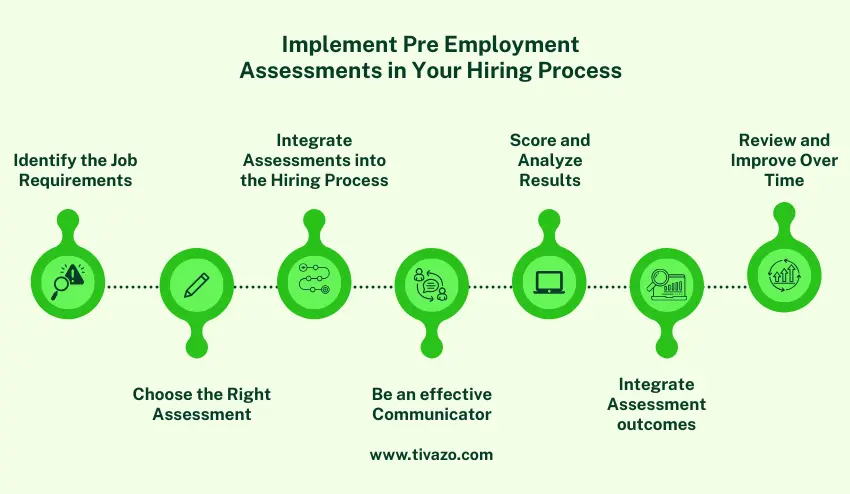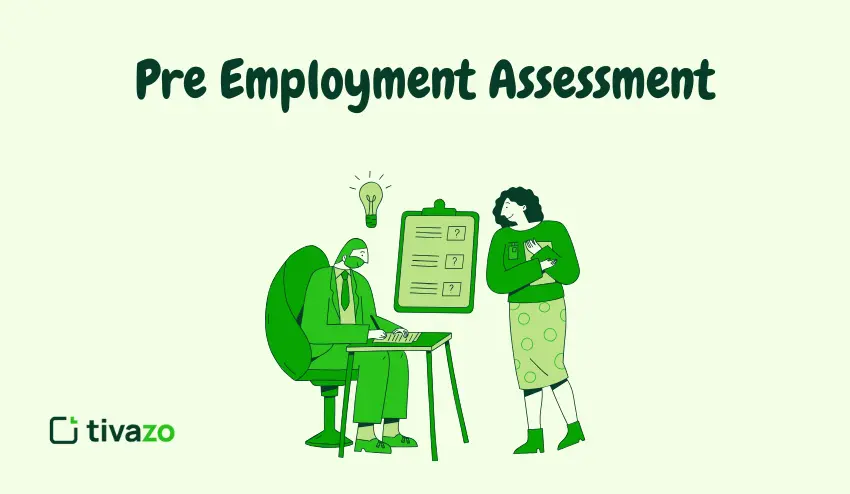Recruiting the wrong individual might be a cost beyond money. It translates to wasting time, reduced morale in the team, and even customer dissatisfaction. You can imagine how agonizing and expensive it is to replace a new employee within a few months.
This is where a pre-employment evaluation comes in. Rather than just using resumes and interviews alone, you employ structured tests to evaluate hard skills, soft skills, behavior, and job fit. In that manner, you base recruiting decisions on actual evidence rather than on a hunch.
I will take you through all you need to know about pre employment assessment in this guide. You will know what they are, why they are important in the hiring process today, the various types of tests, the legal aspect that you cannot afford to ignore, and how to use them step by step. At the end, you will have a clear roadmap to recruit smarter, faster, and more equitably.
Let’s start with the basics.
What is a Pre Employment Assessment?

Pre employment assessment is any test that is used to measure the abilities of a candidate before joining your company. These tests are used to test aspects like problem-solving, communication, technical knowledge, personality or even physical ability.
Assessments provide you with structured results as opposed to interviews which may be subjective. To illustrate, two applicants can claim to be good at Excel. A skills test, on the other hand, will tell you who is capable of doing the job required.
Pre employment tests do not substitute interviews, background checks or reference checks. Rather, they provide one more level of evidence to enable you make more credible hiring decisions.
This brings us to the larger question: why then should you use them now more than ever?
Why Pre Employment Assessment Matters Today
Recruitment is now a very complicated game to play. Remote work, AI-created resumes, and large volumes of applications make it more difficult to identify the right talent. Hundreds of applications can be received on one job posting. It is easy to overlook the best candidates without structure.
Pre employment assessment helps to filter the applicants in a fair and fast way. You do not have to spend hours filtering through resumes to find the candidates who show the skills you require. It implies less time wasted on interviews and more time on serious candidates.
Reduction of bias is another reason why these assessments are important. Conventional recruitment tends to give preference to people who perform well in interviews, rather than those who perform well. Assessments also level the playing field because they look at measurable performance rather than first impressions.
Lastly, pre employment assessments are cost-effective. A bad employee can cost the company 30 percent of the initial salary of the employee. Assessments minimize this risk because you are more likely to get the right person the first time.
Having told you why they are important, now we can discuss the various types of assessments you can employ.
Types of Pre Employment Assessments
Not every assessment is the same. The appropriate test is based on the job, business, and ability you wish to assess. The following are the most popular forms of pre employment assessment.

1. Cognitive Ability Tests
These test the skills of a candidate in solving problems, logical thinking as well as the skills of acquiring knowledge fast. An IT position, as an example, may employ cognitive tests to determine the ability of an individual to solve technical problems under pressure. Cognitive ability tests are good predictors of job performance since they determine how quickly an individual adapts to new situations.
2. Skills Tests
Skills tests assess certain knowledge or skills required in a job. An accountant can be required to take a financial analysis test, whereas a copywriter can be required to take a writing test. These are practical and direct since they consider the work that the job actually involves.
3. Personality Tests
Personality tests reveal how the traits of a candidate fit within your company culture and job expectations. They quantify such things as teamwork, motivation, and leadership style. Personality tests do not have to be the sole determinant in the hiring process, but they can help you anticipate long-term fit and prevent mismatches.
4. Situational Judgment Tests (SJTs)
SJTs also provide the candidates with work-related situations and inquire how they would react. To illustrate, a customer service position may involve a situation involving dealing with an irate customer. These tests show the decision-making style, judgment, and problem-solving in a real-world situation.
5. Physical Ability Tests
Physical ability tests are used to verify that candidates are physically able to perform the required tasks, in work positions that involve physical work, like construction work or warehouse work. These can be strength checks, stamina checks or coordination checks.
6. Emotional Intelligence (EI) Tests
Emotional intelligence refers to the capacity to be aware of emotions and to control them in oneself and in others. Jobs that require good interpersonal skills such as sales or management are good to use EI tests. Applicants that are more emotionally intelligent usually manage stress and teamwork.
7. Integrity Tests
These are honesty, ethics and reliability. They are mostly employed in jobs that require working with money or security or sensitive data. Integrity tests minimize the possibility of stealing, committing fraud or misconduct.
When you add together two or more of these tests, you get a better image of the potential of a candidate. An example is the combination of a skills test and a personality test to balance technical capability and cultural fit.
Benefits of Pre Employment Assessments for Employers and Candidates
Pre employment assessment helps both parties involved in the hiring process. Employers will have a more accurate hiring process, and candidates will receive a more reasonable assessment. Let’s break this down.
Benefits for Employers
- Better Hiring Decisions
Tests minimise guesses. You receive quantifiable information about skills, behavior, and fit, rather than just using resumes or interviews. This will save you the expense of poor hires. - Time and Cost Savings
It may take weeks to screen hundreds of resumes. A properly-constructed pre employment assessment will help you weed out candidates in a short time so that you can concentrate on the best. This saves the time and money spent by recruiters. - Reduced Bias
Unconscious bias can affect interviews. Assessments standardize the process, by administering the same test to all candidates in the same circumstances. This enhances equity and equality in employment and improves inclusion in the workplace. - Improved Job Performance
When job-relevant skills are tested, you have a higher chance of hiring an individual who will perform well on the first day. It translates to accelerated onboarding and productivity. - Lower Turnover Rates
The wrong person to hire will result in early exits. Through the assessment, you get the candidates who are more appropriate to the position and corporate culture. That saves replacement costs and turnover.
Benefits for Candidates
- Fair Evaluation
Applicants are evaluated based on real skills and abilities and not on contacts, resume or interview flair. This puts the playing field even. - Transparency in Hiring
When the tests are clear, the applicants are aware of what is required. They also know that they are being assessed and this creates confidence in the process. - Opportunities to Shine
Other candidates are not good interviewers but good at skills tests. Examinations provide them with a different means of demonstrating their potential. - Better Job Fit
Applicants who undergo pre employment assessment are better placed to work in positions that suit them. This enhances satisfaction at work and long-term development.
In brief, pre employment tests are a win-win situation. Smarter people are employed, and the candidates receive equal opportunity to demonstrate their skills.
How to Implement Pre Employment Assessments in Your Hiring Process
Pre employment assessment can only be effective when it is designed and guided by your employment objectives. The following is a clear framework to be followed.

Step 1: Identify the Job Requirements
Start by doing a job analysis. Divide the role into hard skills, soft skills, and behavioral characteristics that are necessary. To give an example, a sales manager might require communication skills, collaboration skills, ability to solve problems, and endurance, whereas a software engineer might require coding skills and logical thinking.
This will help you to evaluate what the job actually needs.
Step 2: Choose the Right Type of Pre Employment Assessment
Match the test to the job duties.
- Apply skills tests to technical jobs.
- Include personality tests to test cultural fit.
- When it comes to jobs that require making decisions fast, consider situational judgment tests.
A combination of two tests (such as a skills test + personality test) is often the best balance.
Step 3: Integrate Assessments into the Hiring Process
Determine when the assessment should be used. It can be added immediately after the application phase in some companies and immediately after the first interview in others. The key is consistency. All applicants for the same position are expected to be tested in the same conditions. This makes hiring more fair.
Step 4: Be an effective Communicator with Candidates
Always clarify what the assessment is and how it will be utilized. Applicants appreciate openness in recruitment and it fosters trust in your brand as an employer. A brief email with the format of the test and the expected time is a good way to lessen anxiety and increase completion rates.
Step 5: Score and Analyze Results
After the tests are done, apply clear scoring. One should not compare the raw scores but should compare the results to role benchmarks. Modern predictive hiring tools can allow recruiters to save time, as these tools can both automate scoring and identify the most successful candidates.
Step 6: Integrate Assessment outcomes with other hiring techniques.
Pre employment assessments are powerful, but they shouldn’t stand alone. Integrate them with structured interviews, reference checks, and background checks. This provides you with a total image of the candidate.
Step 7: Review and Improve Over Time
Monitor the performance of the hired employees who performed well in your tests. Are they doing what they are supposed to do? If not, adjust the tests. A pre employment assessment plan must change according to your business requirements and the talent market.
Legal Considerations and Compliance in Pre Employment Assessments
There are legal liabilities associated with the use of a pre employment assessment. Otherwise, the assessments can result in discrimination claims or regulatory problems. Compliance is an important aspect of hiring that must be understood.
1. Equal Opportunity and Anti-Discrimination Laws
In most nations, such as the U.S., the EEOC (Equal Employment Opportunity Commission) stipulates that the assessments must not discriminate candidates on the basis of race, gender, age, disability, and generally other protected factors. This implies that your tests should be job related and should be proven to be valid to a certain job.
2. Americans with Disabilities Act (ADA)
The ADA does not allow anyone to discriminate against people with disabilities. Evaluations should be available on all platforms such as mobile phones and assistive technologies. Before offering employment, employers are not supposed to ask questions or to administer medical tests that are related to health. Psychological or medical tests must be applied only when the tests are relevant to the job and are in line with the business requirements.
3. Privacy and Data Protection
Assessment data that contains information about candidates should be safeguarded in accordance with the applicable privacy legislation, including GDPR in Europe and other local standards. To ensure trust and legal compliance, employers are advised to disclose how candidate data is stored, used, and retained.
4. Background Checks and Consent
In carrying out background checks as part of pre employment assessment, consent on the part of the candidate is obligatory. In the US, employers are required to comply with legislations like the Fair Credit Reporting Act (FCRA) including notifying the applicant in case adverse action is taken against them based on the results. There are also some ban-the-box laws limiting when criminal history may be requested.
5. Ensuring Non-Discrimination and Fairness
Administer job-related, validated tests to reduce chances of discrimination. Do not use exams that are a medical examination unless there is a need to do so based on a job requirement. Always carry out tests on every candidate to ensure there is fairness during the hiring process.
6. Regional Specific Regulations
Some regions, such as Ontario, Canada, have certain regulations that compel pre-employment disclosure of employment terms by July 2025. Employers are required to be abreast of changes in regional employment law that affects pre-employment assessments and communication with candidates.
These guidelines will ensure that your pre employment assessment process is legally compliant, fair and effective, and will provide you with reliable data, and minimize the risks that may arise.
How to Choose the Right Pre Employment Assessment Tools
It is important to choose the appropriate tool in order to conduct effective pre employment assessments. The perfect platform provides precise outcomes, attracts candidates, and makes hiring decisions that are well-founded.
1. Define Hiring Needs and Testing Goals
Begin by defining the job requirements and the technical, cognitive, and soft skills required. Determine what the assessment is intended to measure: proficiency in skills, personality, cultural fit, or a blend of the two. The closer the tests are to role-specific competencies, the higher the predictive accuracy and the probability of successful hiring.
2. Prioritize Customizability and Relevance
Select the tools that provide the ability to tailor questions or test modules to fit a particular job role. Tailor-made tests are more relevant than generic off-the-shelf tests. This is so that all the assessments determine what is actually important to the position and provide you with hiring information.
3. Consider Candidate Experience
The assessments must be interesting, timely, and user-friendly to avoid drop-offs among the candidates. Ask different types of questions so that candidates are not bored. The positive experience of the candidate assessment enhances your employer brand and inspires the best talent to go through the process.
4. Evaluate Features and Integration
Search for websites that have a wide range of reliable tests, including skills, personality, and situational judgment tests. The best tests will have the following features: anti-cheating, real-time feedback, reporting analytics, and candidate management. The workflow can integrate with some Applicant Tracking Systems (ATS) like Greenhouse or Lever to keep candidate data centralized.
5. Budget and Scalability
Understand the pricing types such as subscription and pay-as-you-go pricing or enterprise quote. Check if the tool meets your current hiring volume and that it will also scale with your company without additional cost. A scalable tool means a lot less need to change tools frequently.
6. Compliance and Fairness
Choose assessment tools which are known to reduce bias and legal compliance. Tests are continuously being updated by legitimate providers based on scientific evidence and job market requirements. This will aid in equity in pre employment testing, and minimize legal risk.
Popular Pre Employment Assessment Tools in 2025
- TestGorilla: Large test library, customizable, affordable to SMBs, and lots of integrations.
- eSkill: Can be customized, can be built to order, can be used in tandem with video interviews, niche jobs.
- Vervoe: AI driven, is continuously trained through active learning, template diversity, encourages interaction.
- Xobin: Practical tests, joint hire, user-friendly, skill-based.
- TalentSorter: Excellent psychometric focus, cognitive and personality, minimum bias.
The selection of an appropriate assessment tool provides you with an effective, fair and efficient pre employment assessment process. It enhances foolproof hiring and job applicant experience.
Conclusion
Pre employment assessment is a key to making smarter, evidence-based hiring decisions. It enables employers to assess the skills, personality, and job fit of candidates in an objective manner that saves time and reduces turnover. Assessments, when used together with interviews, background checks, and organized hiring practices, will give a comprehensive picture of each candidate and contribute to long-term success.
The selection of the appropriate type of assessment, the application of a valid tool, compliance with the law, and regular review of the results are the main factors to maximize effectiveness. Through pre employment assessments, companies can recruit superior candidates more quickly, enhance the performance of employees and create a stronger and high performing team that can grow the business.




